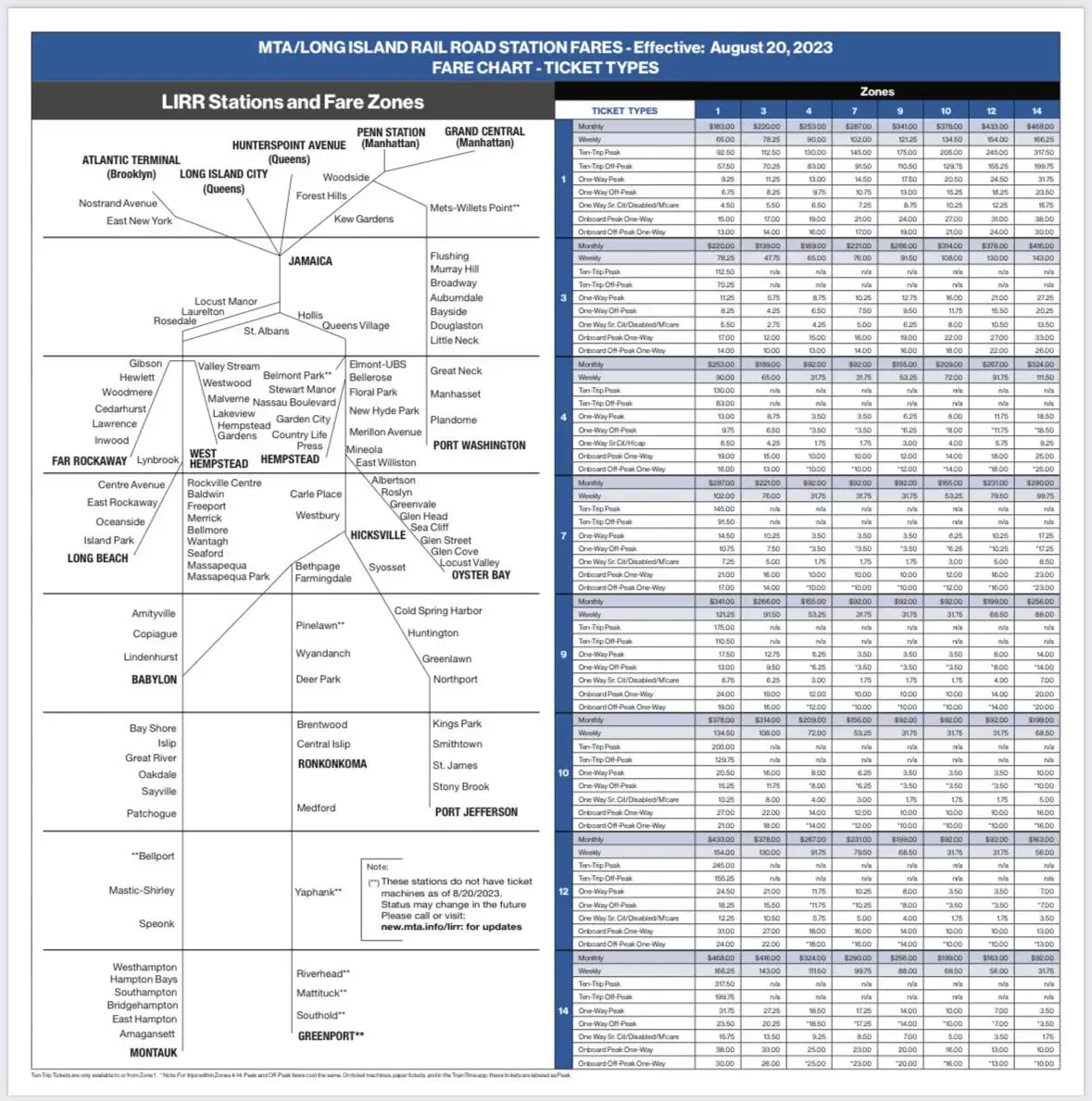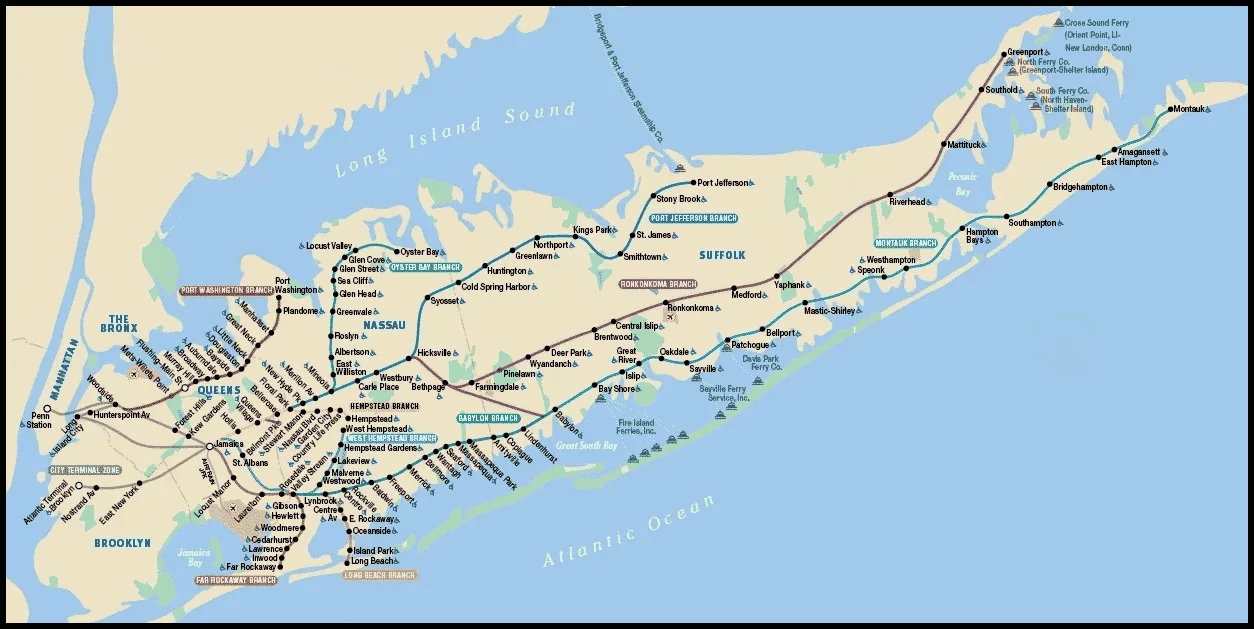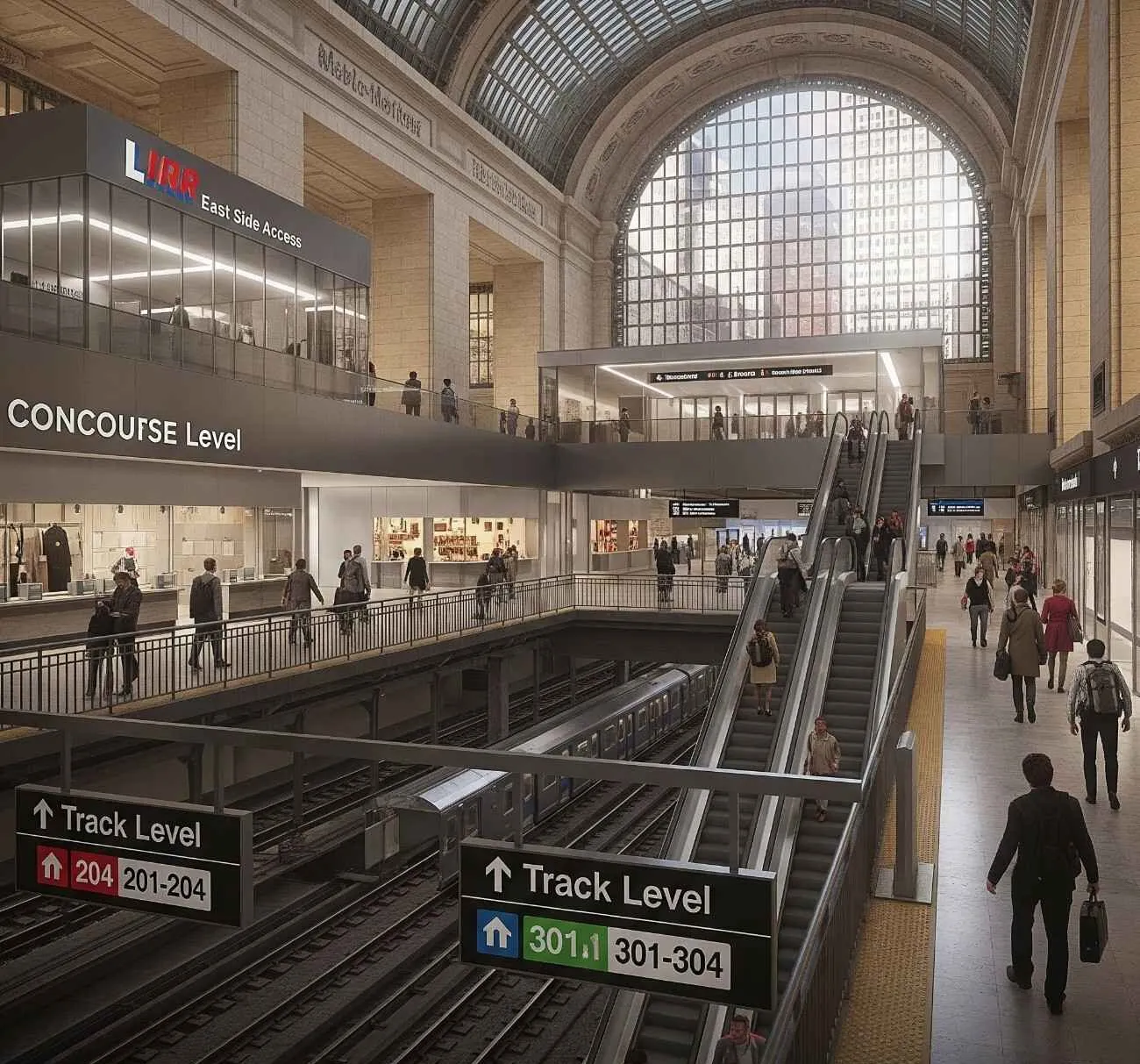LIRR fare prices may depend on the zone in which we are traveling. Traveling within the same zone has the same price, whereas moving to a different zone will increase the price. On the LIRR Map, traveling in LIRR off-peak hours has lower fare prices as compared to LIRR peak hours.
Take a look at the LIRR map and anyone will immediately see a truly massive transit network. This isn’t just any train system; it operates 24/7, covering an impressive 11 branches and 126 stations. The LIRR connects directly from the bustling energy of Manhattan’s Penn Station and Grand Central Madison all the way to the scenic eastern reaches of Suffolk County. Clearly, the LIRR provides a vital transportation choice for everyone – daily commuters, curious visitors, and relaxing weekenders alike. You’ll quickly notice its 11 color-coded branches, each serving multiple distinct regions across Long Island.
Before you hop on, we always advise checking the prices first. Why? Because LIRR fare prices depend directly on your travel zone. For instance, you’ll pay the same price when you travel within the same zone, whereas moving to a different zone will increase your fare. A smart tip for savings: the LIRR map also shows that traveling during LIRR off-peak hours offers lower fare prices compared to the busier LIRR peak hours. The clear picture of Long Island Railroad map is given on the official New York government website: @data.ny.gov/Transportation/Long-Island-Railroad-Map/jbqr-kiev
You may also like:
LIRR Map
The LIRR map is fairly indispensable for making your way around the railroad’s sprawling system. It emphasizes many of the big lines: Babylon, Port Jefferson, Ronkonkoma, and Montauk, to name just a few. Being key transfer points, e.g. Jamaica Station, allow easy transfers between different branches and with other transit services, such as the NYC Subway, local bus services, and the AirTrain JFK to John F. Kennedy International Airport. Weather you are logging in on the commute getting to work, visiting historic landmarks, or beach bound for a vacation, the LIRR map makes it simple to get to your destination without breaking the bank.

The LIRR (Long Island Rail Road) uses zones to figure out how much your ticket costs. Each station belongs to a zone, and the farther apart your start and end zones are, the more you pay.
-
Zone examples:
- Zone 1 = NYC
- Zone 3 = Eastern Queens
- Zone 4 = Western Nassau County
- Zone 7 = Most of Nassau County
- Zones 9, 10, 12, 14 = Parts of Suffolk County (from west to far east)
Ticket prices change based on:
- How far you travel (zone to zone)
- When you travel (peak vs. off-peak)
Peak hours:
- Morning: 6 AM – 9 AM (into NYC)
- Evening: 5 PM – 8 PM (out of NYC toward Long Island)
Example fares (peak time):
- Zone 1 → Zone 7 = $14.50
- Zone 7 → Zone 12 = $10.25
The zone numbers seem a bit random because the LIRR used to have zones 1–15, but they combined some zones and closed lesser-used stations, so now the numbering skips around.
Download Latest LIRR Map: Download the LIRR Map pdf from the official MTA LIRR website: Download Pdf

LIRR Train Map
The Long Island Rail Road (LIRR) map is an essential guide to traveling on one of the busiest commuter rail systems in the U.S. Here’s a breakdown of its main elements and how to use it effectively.
Main Branches & Color Coding
The LIRR network consists of 11 color-coded branches, each serving different regions of Long Island:
| Branch | Key Terminals | Primary Destinations |
|---|---|---|
| Main Line (Gray) | Penn Station, Grand Central, Jamaica | Hicksville, Ronkonkoma |
| Port Washington (Gold) | Penn Station, Grand Central | Flushing, Great Neck |
| Montauk (Green) | Jamaica, Babylon | Patchogue, Hamptons (seasonal) |
| Babylon (Blue) | Jamaica, Atlantic Terminal | Freeport, Babylon |
| Far Rockaway (Red) | Jamaica | Valley Stream, Far Rockaway |
Major Stations & Transfer Points
-
Major Hubs
- Penn Station (Manhattan)
- Grand Central Madison (Manhattan)
- Jamaica (Queens) – Main transfer point for most branches
- Atlantic Terminal (Brooklyn)
-
Connections to Other Transit
- Subway: At Penn Station (1/2/3/A/C/E), Jamaica (E/J/Z), Atlantic Terminal (B/Q)
- Other Rail: AirTrain JFK at Jamaica, Metro-North at Grand Central
How to Read MTA LIRR Map
-
Directional Travel
- “Citybound“ = Heading toward Manhattan (Penn Station / Grand Central)
- “Eastbound“ = Heading toward Long Island
-
Symbols & Markers
- Lightning Bolt: Express service stops
- “P”: Parking available
- Wheelchair: ADA-accessible stations
Digital Map Tools
- Official MTA Interactive Map
- TrainTime App: Real-time train tracking
- PDF Timetables: Branch-specific schedules
Main LIRR Lines and Branches
The LIRR offers service on both electrified and diesel propelled trains, providing you with a safe, convenient way to ride throughout Long Island. Intermediate transfer facilities including Jamaica Station link riders to multiple branches and other rail systems, enhancing travel opportunities. The LIRR was constructed with passengers in mind, offering branches that range in length, frequency, and destinations for all who need to take the train, including daily commuters and weekend adventurers.
| Branch Name | Western Terminal(s) | Eastern Terminal | Electrification | Notes |
|---|---|---|---|---|
| Main Line | Long Island City, Penn Station | Greenport | Partial | Central trunk line; diesel east of Ronkonkoma. |
| Montauk Branch | Long Island City | Montauk | Partial | Electrified to Babylon; diesel west. |
| Babylon Branch | Penn Station | Babylon | Yes | Frequent commuter train service. |
| Port Jefferson Branch | Penn Station | Port Jefferson | Partial | Electrified to Huntington; diesel west. |
| Ronkonkoma Branch | Penn Station | Ronkonkoma | Yes | High-speed train service; connects to Greenport by diesel. |
| Oyster Bay Branch | Penn Station | Oyster Bay | Partial | Electrified to East Williston; diesel west. |
| Hempstead Branch | Penn Station | Hempstead | Yes | Services Nassau County central area. |
| West Hempstead Branch | Penn Station | West Hempstead | Yes | Short branch for residential areas. |
| Long Beach Branch | Penn Station | Long Beach | Yes | Busy with beach patrons; high frequency. |
| Far Rockaway Branch | Penn Station | Far Rockaway | Yes | Serves southeastern Queens. |
| Belmont Park Branch | Penn Station | Belmont Park | Yes | Special seasonal service for events at Belmont Park. |

LIRR Penn Station Map
The Long Island Rail Road (LIRR) concourse at New York’s Penn Station is a major transportation hub for commuters traveling between Manhattan and Long Island. Recent renovations have greatly improved the concourse, making it more spacious, accessible, and modern.
LIRR Penn Station Concourse Layout
The LIRR concourse is located two levels below street level and stretches from Seventh Avenue (near the 1/2/3 subway lines) to Eighth Avenue (near the A/C/E subway lines), offering easy connections to various transit options. The concourse is split into several key sections:
- Main Concourse: This is the main waiting and ticketing area for LIRR passengers.
- East End Gateway: This new entrance, opened in December 2020, connects the concourse to 33rd Street and Seventh Avenue, providing direct access to the LIRR and subway lines.
- Platforms: The concourse connects to 21 tracks that serve trains heading to various destinations on Long Island.
Navigating the Concourse
For those unfamiliar with the station, there are several resources to help with navigation:
- Digital Signage: Train schedules and platform information are displayed on large digital screens throughout the concourse.
- Interactive Kiosks: Kiosks located between Tracks 14 and 15 provide tactile maps and audio directions to help guide passengers.
- Customer Service: Ticket machines and customer service staff are available to assist with ticketing and any general inquiries.
Access Points
- East End Gateway: Located at 33rd Street and Seventh Avenue, this entrance connects directly to the LIRR concourse and subway lines.
- Main Concourse: Accessible from 34th Street and Seventh Avenue, this entrance leads to the main waiting and ticketing area.
- Subway Connections: The concourse connects to the 1/2/3 and A/C/E subway lines, allowing for easy transfers between different transportation options.
LIRR Grand Central Map
Grand Central Madison is the new East Side terminal of the Long Island Rail Road (LIRR), a major expansion of New York City’s transportation network. Officially opened in January 2023, the new complex provides LIRR service to Manhattan’s East Side for the first time, providing commuters with a quicker, more convenient trip to and from Long Island.

Station Layout
Grand Central Madison takes up four levels below the historic Grand Central Terminal:
- Concourse Level: The public middle section featuring ticket booths, waiting rooms, bathrooms, customer service, and shops.
- Mezzanine Level: Over the platforms, this level offers access to down-escalating escalators to the tracks.
- Track Levels: Two levels for trains:
-
- Upper Track Level: Tracks 201 and 202 (west side), and 203 and 204 (east side).
- Lower Track Level: Tracks 301 and 302 (west side), and 303 and 304 (east side).
The station features color-coded signs to facilitate wayfinding and the MTA’s longest escalators—182 feet, which take nearly two minutes to travel from the concourse to the platforms.
Access Points
Grand Central Madison has multiple entrances:
- 383 Madison Avenue: Southeast corner of 47th Street.
- 42nd Street: East of Madison Avenue.
- 43rd Street and Vanderbilt Avenue: Southwest corner.
- 44th Street: Madison and Vanderbilt Avenues (elevator only).
- 48th Street: Madison and Park Avenues (elevator only).
The station also connects with the Metro-North Terminal and the One Vanderbilt building, making other forms of transport readily accessible.
Operating Hours
- Grand Central Madison operates daily from 5:30 a.m. to 2:00 a.m.
- During late-night (2:00 a.m. to 5:30 a.m.) operating hours, all LIRR service to Manhattan is relocated to Penn Station.
Amenities
- Ticket Office: On 47th Street, 6:10 a.m. through 1:15 a.m. daily.
- Waiting Areas: On the concourse level near 47th Street, and a new 28-seat customer seating area on the mezzanine level (90-minute time limitation).
- Restrooms: On the concourse level between 44th and 45th Streets, between 46th and 47th Streets, and near the 47th Street entrance. Restrooms are not found on the platform levels.
- Retail and Restaurant: Shops and restaurants are planned for the concourse level but are not yet open.
LIRR tickets
| Ticket Type | Valid For | Peak Fare | Off-Peak Fare | Notes |
|---|---|---|---|---|
| One-Way | Single continuous journey | Full fare by zones | 20% discount off peak | Valid for two hours; unlimited transfers within window |
| Round-Trip | Outbound and return same day | ~90% of two one-ways | ~90% of two off-peaks | Return leg must be used same day |
| 10-Trip | Ten one-way rides | ~85% of ten one-ways | ~85% of ten off-peaks | Each ride valid two hours; best for infrequent commuters |
| Weekly Pass | Unlimited travel for 7 consecutive days | Flat weekly rate | Same weekly rate | Use if daily round trips > cost of pass |
| Monthly Pass | Unlimited travel for a calendar month | Flat monthly rate (~16 peak rides) | Same monthly rate | Best for frequent riders; savings increase with usage |
| CityTicket | Any trip wholly within NYC (Zones 1–3) weekends/holidays | $5 per one-way | $5 per one-way | Applies only on weekends & major holidays; no transfers to non-LIRR services |
| Family Fare | Children 5–11, accompanied by adult | 50% of adult fare | 50% of adult off-peak fare | Up to two children under 5 ride free per adult |
| Reduced-Fare Program | Seniors (65+) & customers with disabilities | 50% of adult peak fare | 50% of adult off-peak fare | Enrollment required; RTW and multi-ride passes available at reduced rates |
Frequently Asked Questions
1. How are LIRR prices determined?
LIRR fares are distance-based, with the fare increasing according to distance traveled. Zone 1 has NYC terminals, and fares increase in a northeasterly direction through Zone 14 in Suffolk County. All stations in a zone are the same price.
2. What kind of tickets are available?
LIRR offers One-Way, Round-Trip, Ten-Trip, Weekly, and Monthly tickets. Special tickets like CityTicket and Far Rockaway Ticket offer discounted fares for traveling in NYC.
3. What are peak and off-peak fares?
Peak fares apply on weekdays to trains that arrive in NYC terminals between 6–10 AM and depart between 4–8 PM. All other times are off-peak, with lower prices and potential savings.
4. How do I buy tickets?
LIRR tickets may be purchased through the MTA TrainTime app (iOS/Android), station machines, or ticket offices. Onboard purchases incur an added fee unless traveling from machine-less stations or if entitled to exemptions.
5. What is CityTicket?
CityTicket provides reduced LIRR fares for NYC journeys (Zones 1–3). Through March 2025, off-peak tickets are $5 and peak-time tickets $7. They’re available on the TrainTime app, ticket machines, or offices.
6. What is the Far Rockaway Ticket?
Debuted in August 2023, the Far Rockaway Ticket offers CityTicket-like fare reductions for trips from Far Rockaway to other NYC stations. It can be bought at the station or via the TrainTime app when nearby.
7. What is the Combo Ticket?
The Combo Ticket lets riders take LIRR and Metro-North Railroad trains through Grand Central Madison. At $8 above the cost of an off-peak adult fare from an origin on one system to Grand Central, it is a convenient choice for riders who must travel both railroads in an outing.
8. Does there exist a senior or disability discount?
Yes, there are discounted fares for seniors (65+) and passengers with disabilities, and for Medicare beneficiaries, up to 50% of One-Way Peak fare. Identification is required, and these fares may not be used during inbound weekday morning Peak trains.
9. Can I travel on any train?
You can transfer tickets from one zone to the other on which they have been bought. You may travel on any train traveling through those zones irrespective of the stations it goes through. For instance, a Zone 1 to Zone 12 ticket can be traveled on any train traveling between those zones.
10. What is the consequence if I travel without purchasing a ticket?
If you are traveling without a ticket by train, you can buy one from the conductor. A surcharge is additional, and you will have to pay the difference in fare if traveling beyond the zones indicated on your ticket.

How can I get from JFK to Bay Shore? Do I need to go to the Atlantic Terminal?
No, you don’t actually need to go to Atlantic Terminal. You can take Airtrain from JKF to Jamaica Station. Then transfer to LIRR Train on Montauk Branch going towards Bay Shore.